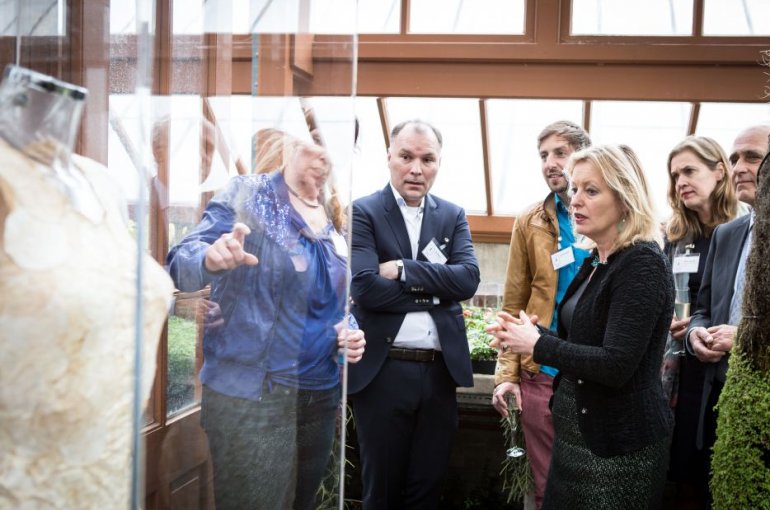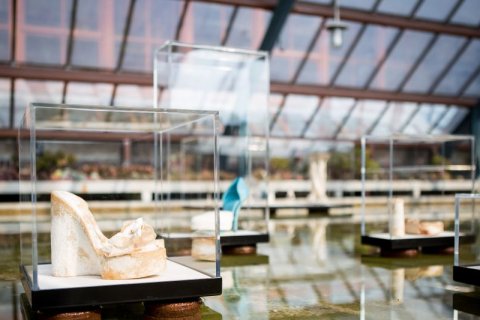Exhibition Fungal Futures: sustainable designs thanks to fungi
Minister Bussemaker: “Seldom do education, culture and science come together so beautifully”

Starting today at the University Museum: A dress made from fungi. A combination of design and research into the application of innovative sustainable materials. The dress is part of the exhibition ‘Fungal Futures / Growing Domestic Bio-Landscapes’, which was officially opened by Jet Bussemaker, Minister of Education, Culture and Science, on Wednesday, 23 March. The exhibition is the successful result of a unique collaboration between Prof. Han Wösten from Utrecht University and Maurizio Montalti from design studio Officina Corpuscoli. The two will continu their partnership.
“Seldom do my Ministry’s three priorities of education, culture and science come together so beautifully”, exclaimed an enthusiastic Minister Jet Bussemaker. “This exhibition and the multi-disciplinary project behind it show how research and the social applications of that research can both make giant leaps when you put researchers and designers, scientists and artists and thinkers and dreamers together.”
Nature’s own recyclers
Fungi are nature’s own recyclers: they survive by digesting the remains of plants and wood. Fungal Futures shows how scientists and designers are utilising this characteristic to create functional materials from plant-based waste, such as sawdust and straw. The research group led by Prof. Han Wösten together with designer Maurizio Montalti has developed a series of fungal materials, and 11 international artists and designers have studied their possible practical uses. Fungal Futures presents some of the wide range of applications that they have developed for these innovative, sustainable materials: from shoe to dress and from brick to chair.

Combination of characteristics
Fungal materials are already used for simple applications, such as packaging and insulation materials. They are created by mycelium, the fibrous network that make up fungi. Depending on the type of fungus, the mycelium - and therefore the finished material - can be rigid or elastic, porous to water, brittle, heat-resistant, and much more. “Since we can modify fungi relatively easily, it should be possible to create the right combination of characteristics for a wide range of applications. So we can produce materials for furniture, but also substances that resemble rubber, textiles and even leather”, explains Han Wösten, Professor of Microbiology at Utrecht University.
Fundamental research
In the meantime, Wösten explains that their research is also interesting for fundamental science. “The role that fungi play in nature is to break down wood and other plant-based materials. We have a fairly good understanding of the enzymes they use to do that, but the question is how the fungi are able to penetrate into the wood and plant branches. Research into the material characteristics of the mycelium in fungi can help us to understand that better.”
Next steps
Fungal Futures is the result of the NWO-funded research project ‘Mycelium Design’ conducted by Han Wösten in cooperation with Maurizio Montalti and the Mediamatic Foundation. Han Wösten and Montalti are working together with the Design Academy Eindhoven, TU Delft and several companies to develop further fungal materials and applications. This follow-up project is financed by the STW Technology Foundation.
Artists
Aniela Hoitink - NEFFA / Caroline de Roy / Studio Eric Klarenbeek / Francesco Zorzi - No-Rocket / Gianluca Tabellini / Jonas Edvard / Kristel Peters - COJAK / Maurizio Montalti - OFFICINA CORPUSCOLI / Phil Ross / Studio LIVIN / Wim van Egmond /
More information
- Website about the exhibition
- Report of the Kennis van Nu (Dutch)
- Video ‘Fungi: the plastic of the future’, with, amongst others, Han Wösten and Maurizio Montalti (English under titles)
- Photo's: Lize Kraan
The exhibition Fungal Futures has been financed in part by the Netherlands Organisation for Scientific Research (NWO), the STW Technology Foundation, the City of Utrecht, the Utrecht University Museum, the K.F. Hein Fund, CNC Exotic Mushrooms and Utrecht University.
Contact
- Monica van der Garde, Press Spokesperson, Faculty of Science, m.vandergarde@uu.nl, + 31 (0)6 13 66 14 38.
- Annebeth Felet, Press Spokesperson, Utrecht University Museum, +31, (0)30 - 253 8728, a.felet@uu.nl.

